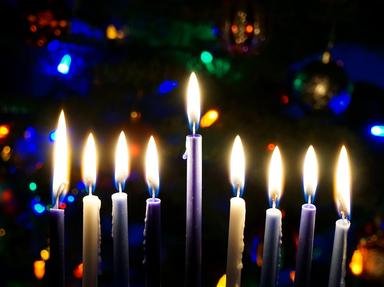Quiz Answer Key and Fun Facts
1. I walk in and see tables set for a meal. There is a plate with three Matzot, a wine goblet marked for the prophet Elijah, and a large platter with a bunch of symbols on it. One of them is labeled "Beitzah". Which holiday am I celebrating tonight?
2. I walk into the sanctuary for services on Erev Shabbat, and in addition to the two regular candlesticks, there is a special Nine-Pronged Menorah which the congregation is getting ready to light. After the service, at the Oneg (reception), it seems like all of the food has been fried in oil, and there are Dreidels all around the room. In addition to Shabbat, which holiday is happening at the moment?
3. Oh, I do love the sound of the Shofar. There was a whole service dedicated to it today! Afterwards, I sat down with my friends and family for a wonderful snack of round challah and apples with honey. Hmmm, I remember not going in to work this morning so I could be at the synagogue... but which holiday is it?
4. Good thing I have ten fingers to keep track! This morning in services, the congregation stood for the reading of the Parasha (Torah portion) where Moses and the Israelites receive the Ten Commandments and then sat down and listened to the recitation of the Book of Ruth. Last night I stayed up all night studying and eating dairy foods. Which holiday am I observing?
5. I wish I could remember which holiday this is... it's so much fun! Let me give you the run-down: I arrived at synagogue in a silly costume, and was handed something that the person next to me called a graggor. I then went inside and heard a very fast yet animated reading of the Megilat Esther (Book of Esther). On my way out, everyone was acting really crazy and eating something called hamentashen. What is the name of this crazy and upside-down holiday?
6. I walk into the synagogue and, although the snow is still melting here in Philadelphia, the building is adorned with beautiful flowers and blossoms. I sit down at a table in the social hall and in front of me are four plates, each with a different variety of fruits or nuts. What sort of a Seder am I attending?
7. My friend Michael got married last year, and now he is sitting next to me in synagogue praying in the white Kittel that he wore on his wedding day. Also, looking around, everyone is very somber and praying either in his stockings, or in non-leather shoes. Which holiday is this?
8. The synagogue has a very somber feel today. Many people are sitting on the floor or on low benches and are listening to the chanting of Megilat Eicha (Book of Lamentations). What holiday is this?
9. Wow, this is a holiday that I actually recognize. It is the booth festival of Sukkot. During the course of this week, I plan on resting in an outdoor temporary hut where I will also eat meals and recite special blessings while shaking my lulav and etrog. One other thing that I know about Sukkot is that, while it is an agricultural holiday, it is not one of the three pilgrimage festivals. Is this last statement true or false?
10. I come home from synagogue in the evening to find my dining room table set with a glass of wine, two braided loaves of challah, and two candles, which I must have lit earlier, but can't seem to recall... what holiday is it?
Source: Author
Smurphie
This quiz was reviewed by FunTrivia editor
LeoDaVinci before going online.
Any errors found in FunTrivia content are routinely corrected through our feedback system.

